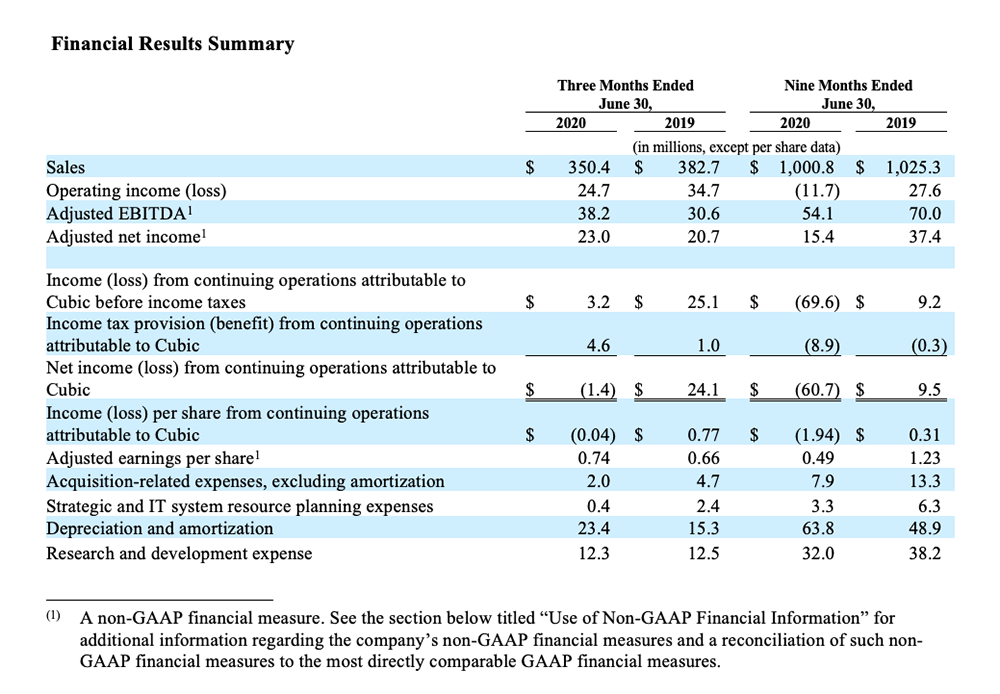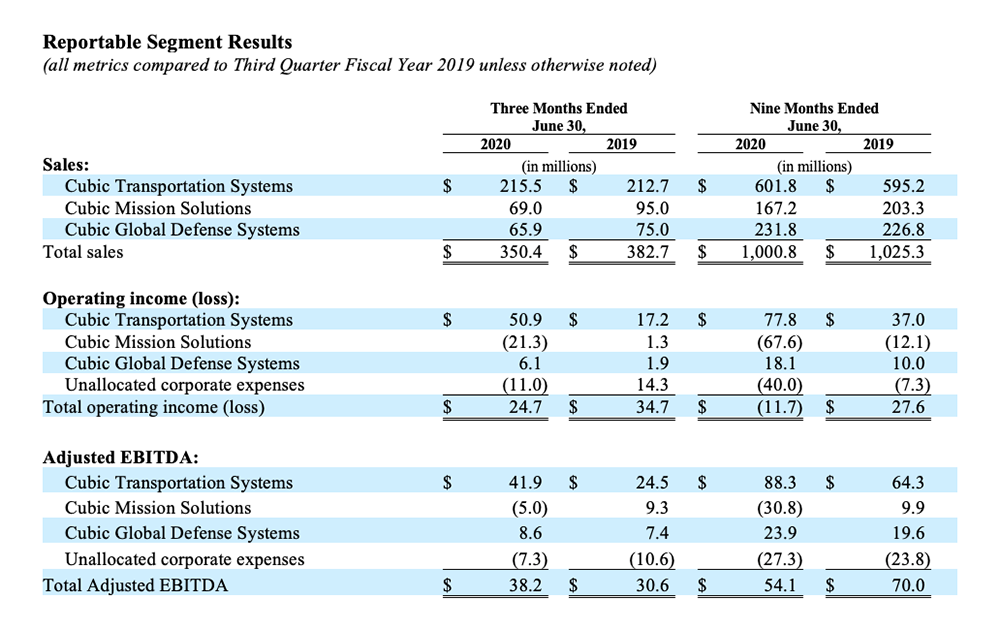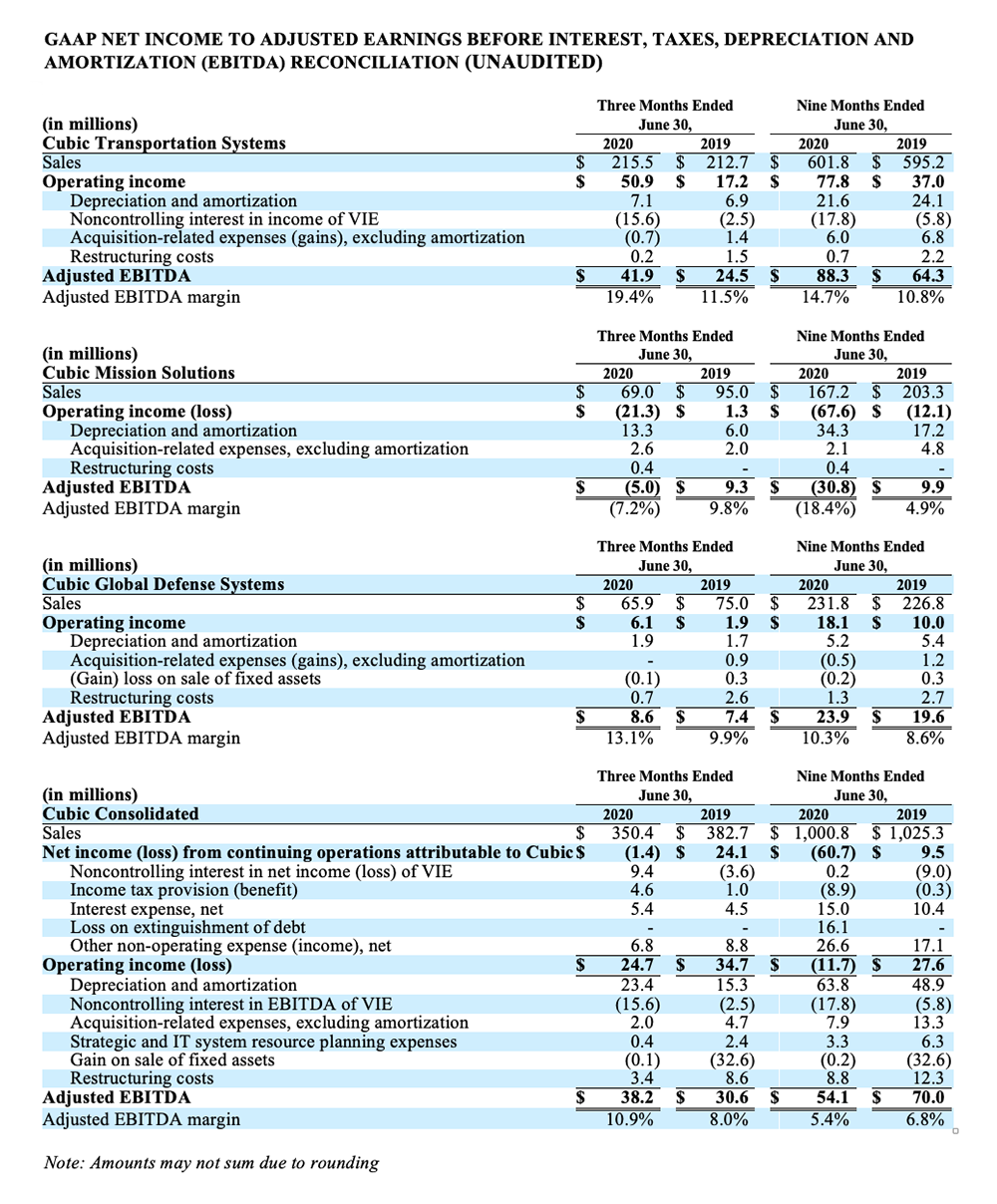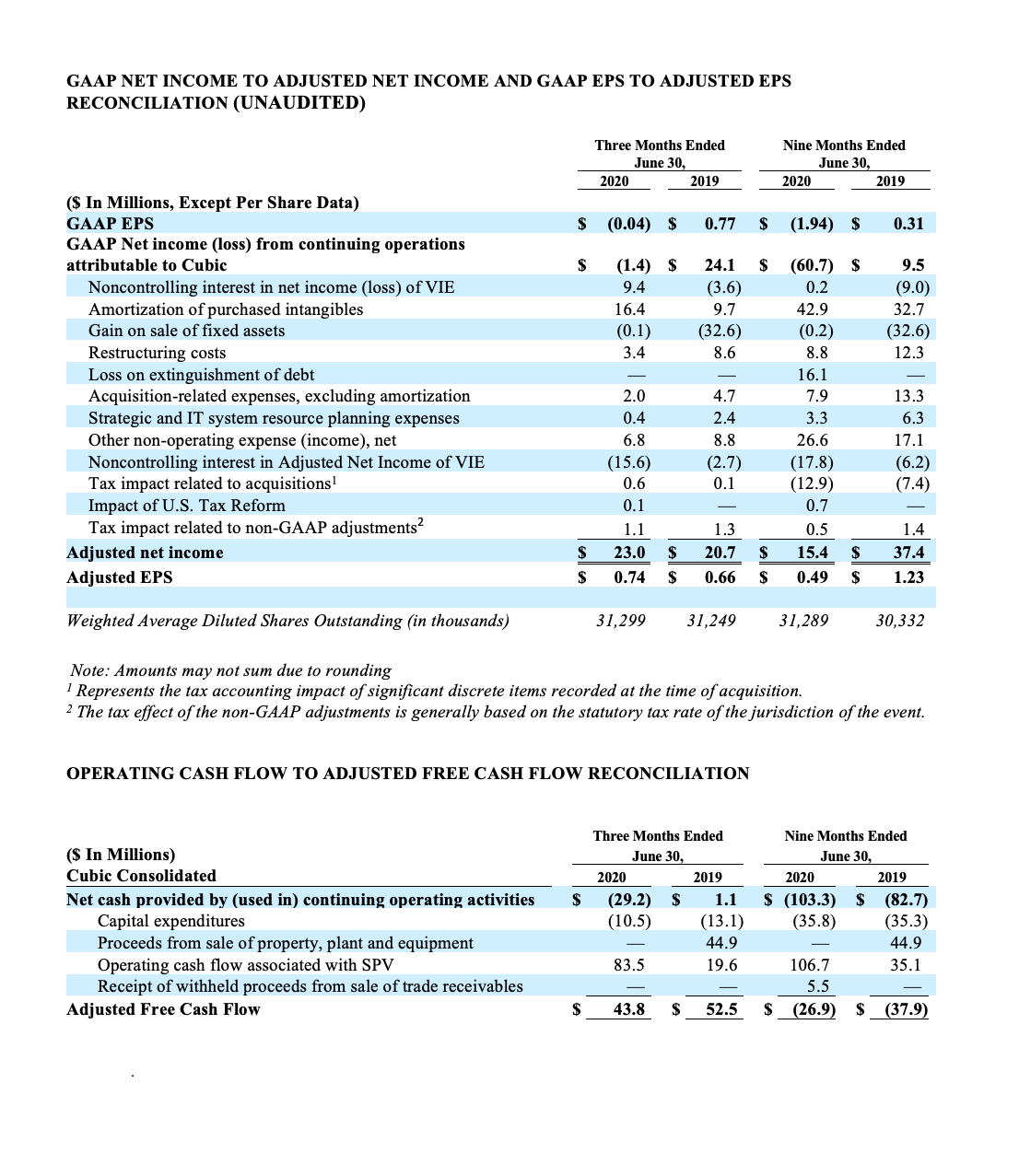SAN DIEGO – August 5, 2020 – Cubic Corporation (NYSE: CUB) today announced its financial results for the third fiscal quarter ended June 30, 2020.
Third Quarter Fiscal Year 2020 Highlights
(all metrics compared to Third Quarter Fiscal Year 2019 unless otherwise noted)
- Sales of $350.4 million, down 8%
- Net loss from continuing operations attributable to Cubic of $1.4 million, or $0.04 per share, compared to net income from continuing operations attributable to Cubic of $24.1 million, or $0.77 per share in the third quarter of fiscal 2019; prior year included $32.6 million gain on sale of fixed assets
- Adjusted earnings per share of $0.74, up 12%
- Adjusted EBITDA of $38.2 million, up 25%
- Backlog increased to $3.7 billion, up 10% from fiscal 2019 year-end
- Cubic and Massachusetts Bay Transportation Authority (“MBTA”) closed an amended agreement for delivery of next-generation fare payment system
- Recent, multi-year awards in defense to support future growth: U.S. Air Force Advanced Battle Management System (multiple award, $950 million IDIQ) and $38 million contract to deliver High Capacity Backbone prototype, with significant market opportunity; U.S. Navy Surface Training Immersive Gaming and Simulations (single award, $99 million IDIQ)
- The company estimates unfavorable impacts totaling up to $41 million for Sales and up to $14 million for Adjusted EBITDA as a result of the COVID-19 pandemic
“We are pleased with our performance and strategic progress this quarter, especially in light of the challenging macro environment due to the ongoing COVID-19 pandemic. In the third fiscal quarter, Cubic grew backlog, Adjusted EBITDA and Adjusted EPS and delivered strong Adjusted Free Cash Flow, supported by the successful completion of our Boston contract amendment and disciplined cost management,” said Bradley H. Feldmann, chairman, president and chief executive officer of Cubic Corporation. “We continue to help our transportation customers deliver solutions that enhance safety and provide insights to support COVID-19 recovery. The health and safety of our team, partners and community remains our top priority and we are committed to fostering an inclusive workplace where everyone is respected, supported, empowered and has the opportunity to drive innovation - Cubic’s lifeblood.”
COVID-19 Business Update
As a provider of essential products and services, Cubic’s businesses have remained operational during the ongoing COVID-19 pandemic. The company remains focused on keeping its employees and customers safe through increased sanitation measures as well as social distancing and additional safety protocols. While Cubic has not experienced significant disruptions in its supply chain or manufacturing facilities to date, the pandemic has presented challenges and impacts on each of its businesses, including delays of customer orders, slowdown of certain projects and impacts due to travel restrictions and remote work. The company estimates that these unfavorable impacts relating to the COVID-19 pandemic totaled up to $41 million for Sales and up to $14 million for Adjusted EBITDA in the third quarter of fiscal year 2020. The company’s proactive efforts to ensure business continuity, coupled with disciplined cost management, partially mitigated the disruptions caused by COVID-19 on the company’s operations and financial performance for the period. Additional information regarding COVID-19 can be found in Cubic’s most recent Quarterly Report on Form 10-Q.
Consolidated Third Quarter Fiscal Year 2020 Results
(all metrics compared to Third Quarter Fiscal Year 2019 unless otherwise noted)
Sales for the third quarter of fiscal 2020 decreased 8% as reported and 9% on an organic basis to $350.4 million, compared to $382.7 million in the prior year period, reflecting declines in Mission Solutions and Global Defense, and partially offset by growth in Transportation Systems. Sales were negatively impacted by COVID-19 due to delayed orders, delays and disruptions to current projects as well as lower transit ridership.
Operating income in the third quarter of fiscal 2020 was $24.7 million, compared to $34.7 million in the prior year period. Operating income was favorably impacted in the prior year due to a $32.6 million gain on the sale of real estate assets. Excluding this impact, the change in operating income in the third quarter primarily reflects an increase in operating income in Transportation Systems, including the Boston MBTA contract amendment and company-wide cost reduction initiatives, offset by an operating loss in Mission Solutions. Amortization of purchased intangibles for the third quarter of fiscal 2020 increased to $16.4 million from $9.7 million in the third quarter fiscal 2019. Additionally, Cubic’s consolidated variable interest entity (“VIE”) recognized higher operating income due to the contract amendment with the Boston MBTA. Operating margin decreased approximately 210 basis points to 7.0%, compared to 9.1% in the prior year period.
Adjusted EBITDA increased 25% to $38.2 million, compared to $30.6 million in the prior year period, driven by growth in Transportation Systems, which benefited from the Boston MBTA contract amendment and company-wide cost reduction initiatives, which partially mitigated the impacts related to COVID-19. Adjusted EBITDA margin increased approximately 290 basis points to 10.9%, compared to 8.0% in the prior year period.
Net loss from continuing operations attributable to Cubic was $1.4 million, or $0.04 per share, compared to net income from continuing operations attributable to Cubic of $24.1 million in the prior year period, or $0.77 per share, primarily reflecting lower operating income and higher taxes.
Adjusted net income was $23.0 million, or $0.74 per share, compared to Adjusted net income of $20.7 million, or $0.66 per share, in the prior year period, reflecting higher Adjusted EBITDA, partially offset by higher taxes and depreciation expense.
Net cash used in continuing operations was $29.2 million, including the impact of consolidating the Boston VIE, compared to net cash provided by continuing operations of $1.1 million in the prior year period. Adjusted Free Cash Flow was $43.8 million, compared to $52.5 million in the prior year period, reflecting a cash receipt from the Boston contract and a milestone payment received from the New York contract. Adjusted Free Cash Flow in the prior year period was favorably impacted by net proceeds from the sale of real estate of $44.9 million.
Cubic Transportation Systems (“CTS”)
CTS sales increased 1% to $215.5 million, compared to $212.7 million in prior year period. Organic sales were up 2%, primarily reflecting growth from next-generation fare payment systems contracts in Boston and the San Francisco Bay Area. CTS was impacted by headwinds related to COVID-19, including delays of new awards, slowdowns of projects and transit ridership decline.
CTS Adjusted EBITDA increased 71% to $41.9 million, compared to $24.5 million in the prior year period, reflecting the Boston contract amendment as well as benefits from the company’s cost savings program, which offset unfavorable impacts related to COVID-19.
Cubic Mission Solutions (“CMS”)
CMS sales decreased 27% to $69.0 million, compared to $95.0 million in the prior year period. Organic sales declined 32% reflecting lower orders and deliveries of expeditionary satellite communications products (“GATR”) due to the timing of shipments.
CMS Adjusted EBITDA decreased to negative $5.0 million, compared to $9.3 million in the prior year period. Adjusted EBITDA reflects lower sales of high-margin GATR products and continued investments in franchise programs.
Cubic Global Defense Systems (“CGD”)
CGD sales decreased 12% to $65.9 million, compared to $75.0 million in the prior year period. Organic sales decline of 11% reflects lower sales in ground combat training systems, partially offset by an increase in air combat training systems work. CGD sales in the third quarter also reflect the delay of international bookings and other expected program awards, including disruptions related to COVID-19.
CGD Adjusted EBITDA increased 16% to $8.6 million, compared to $7.4 million in the prior year period, reflecting continued operational and cost management.
Backlog
Backlog increased by $331.4 million from September 30, 2019 to June 30, 2020. Foreign currency had a favorable impact of $16.5 million during the period.
Balance Sheet and Liquidity
Cubic expects to have sufficient liquidity during the evolving economic conditions surrounding the COVID-19 pandemic. The company has taken a number of recent steps to strengthen liquidity and manage cash flow, including its long-term debt restructuring announced in March 2020 as well as a cost savings program, which is on track for anticipated cumulative net savings of $30 million to $35 million through Cubic’s fiscal year ending September 30, 2021.
Cubic continues to prioritize reducing leverage and, in connection therewith, reduced net debt by $54 million in the third quarter of fiscal 2020. Cubic’s bank net leverage ratio, as defined in its credit agreement, was 3.7x at quarter end, and the credit agreement allows the company to have a net leverage ratio of up to 4.75x through December 2020. Cubic remains focused on cash preservation and lowering its net leverage ratio to its target of below 3.0x in future periods.
Conference Call and Webcast Information
Date: August 5, 2020
Time: 5:00 p.m. ET
Hosts: Bradley H. Feldmann, Chairman, President and Chief Executive Officer
Anshooman Aga, Executive Vice President and Chief Financial Officer
Dial in: 833-968-2299
778-560-2777 (international)
Conference ID 5998881
Webcast: https://event.on24.com/wcc/r/2403361/D0EC3B567D3B92AEA53FA3C06E741AF0
An archive of the webcast will be made available on the Investor Relations section of the company’s website: https://www.cubic.com/investor-relations/earnings.
About Cubic Corporation
Cubic is a technology-driven, market-leading provider of integrated solutions that increase situational understanding for transportation, defense C4ISR and training customers worldwide to decrease urban congestion and improve the militaries’ effectiveness and operational readiness. Our teams innovate to make a positive difference in people’s lives. We simplify their daily journeys. We promote mission success and safety for those who serve their nation. For more information about Cubic, please visit www.cubic.com or on Twitter @CubicCorp.
Media Contact
Laura Chon
Corporate Communications
Cubic Corporation
PH: +1 858-505-2181
Laura.Chon@cubic.com
Investor Contact
Kirsten Nielsen
Investor Relations
Cubic Corporation
PH +1 212-331-9760
Kirsten.Nielsen@cubic.com
Forward-Looking Statements
This press release contains forward-looking statements within the meaning of the Private Securities Litigation Reform Act of 1995 (the “Act”) that are subject to the safe harbor created by the Act. Forward-looking statements include, among others, statements about Cubic’s expectations regarding future events or its future financial and operating performance and delivering on its strategic growth plan. These statements are often, but not always, made through the use of words or phrases such as “may,” “will,” “anticipate,” “estimate,” “plan,” “project,” “continuing,” “ongoing,” “expect,” “believe,” “intend,” “predict,” “potential,” “opportunity” and similar words or phrases or the negatives of these words or phrases. These statements involve risks, estimates, assumptions and uncertainties that could cause actual results to differ materially from those expressed in these statements, including, among others: the impact of the COVID-19 outbreak or future epidemics or pandemics on Cubic’s business, financial condition and operating results; Cubic’s dependence on U.S. and foreign government contracts; delays in approving U.S. and foreign government budgets and cuts in U.S. and foreign government defense expenditures; the ability of certain government agencies to unilaterally terminate or modify Cubic’s contracts with them; Cubic’s assumptions covering behavior by public transit authorities; Cubic’s ability to successfully integrate recently acquired companies, including Trafficware, GRIDSMART, Nuvotronics, Delerrok and PIXIA into its business and to properly assess the effects of such integration on its financial condition and operating results; the U.S. government’s increased emphasis on awarding contracts to small businesses, and Cubic’s ability to retain existing contracts or win new contracts under competitive bidding processes; negative audits by the U.S. government; the effects of politics and economic conditions on negotiations and business dealings in the various countries in which Cubic does business or intends to do business; competition and technology changes in the defense and transportation industries; the change in the way transit agencies pay for transit systems; Cubic’s ability to accurately estimate the time and resources necessary to satisfy obligations under its contracts; the effect of adverse regulatory changes on Cubic’s ability to sell products and services; Cubic’s ability to identify, attract and retain qualified employees; unforeseen problems with the implementation and maintenance of Cubic’s information systems, including Cubic’s enterprise resource planning (“ERP”) system; business disruptions due to cyber security threats, physical threats, terrorist acts, acts of nature and public health crises (including COVID-19); Cubic’s involvement in litigation, including litigation related to patents, proprietary rights and employee misconduct; Cubic’s reliance on subcontractors and on a limited number of third parties to manufacture and supply its products; Cubic’s ability to comply with its development contracts and to successfully develop, introduce and sell new products, systems and services in current and future markets; defects in, or a lack of adequate coverage by insurance or indemnity for, Cubic’s products and systems; and changes in U.S. and foreign tax laws, exchange rates or Cubic’s economic assumptions regarding its pension plans. In addition, please refer to the risk factors contained in Cubic’s filings with the Securities and Exchange Commission (the “SEC”) available at www.sec.gov, including Cubic’s most recent Annual Report on Form 10-K for its fiscal year ended September 30, 2019 and Quarterly Reports on Form 10-Q. Because the risks, estimates, assumptions and uncertainties referred to above could cause actual results or outcomes to differ materially from those expressed in any forward-looking statements, you should not place undue reliance on any forward-looking statements. Any forward-looking statement speaks only as of the date of this press release, and, except as required by law, Cubic undertakes no obligation to update any forward-looking statement to reflect events or circumstances after the date of this press release.
Use of Non-GAAP Financial Information
In addition to results reported under U.S. generally accepted accounting principles (“GAAP”), Cubic provides certain financial measures that are not prepared in accordance with GAAP. These non-GAAP measures consist of organic sales growth, Adjusted net income, Adjusted earnings per share (“Adjusted EPS”), Adjusted EBITDA and Adjusted Free Cash Flow. Cubic believes that these non-GAAP measures provide additional insight into its ongoing operations and underlying business trends, facilitate a comparison of its results between current and prior periods, and facilitate the comparison of its operating results with the results of other public companies that provide non-GAAP measures. Cubic uses Adjusted EBITDA internally to evaluate the operating performance of its business, for strategic planning purposes, and as a factor in determining incentive compensation for certain employees. These non-GAAP measures facilitate company-to-company operating comparisons by excluding items that Cubic believes are not part of its core operating performance. Organic sales growth is defined as the year-over-year percentage change in reported sales relative to the prior comparable period, excluding the impact of acquisitions and divestitures over the prior 12 months and the impact of foreign currency translation. Adjusted EBITDA is defined as GAAP net income from continuing operations attributable to Cubic before interest expense, loss on extinguishment of debt, income taxes, depreciation and amortization, other non-operating expense, acquisition-related expenses, strategic and information technology (“IT”) system resource planning expenses, restructuring costs, and gains or losses on the disposal of fixed assets. Adjusted net income is defined as GAAP net income from continuing operations attributable to Cubic excluding amortization of purchased intangibles, restructuring costs, loss on extinguishment of debt, acquisition related expenses, strategic and IT system resource planning expenses, gains or losses on the disposal of fixed assets, other non-operating expense (income), tax impacts related to acquisitions, and the impact of the Tax Cuts and Jobs Act (“U.S. Tax Reform”). Adjusted EPS is defined as Adjusted net income on a per share basis using the weighted average diluted shares outstanding. Strategic and IT system resource planning expenses consists of expenses incurred in the development of Cubic’s ERP system and the redesign of its supply chain which include internal labor costs and external costs of materials and services that do not qualify for capitalization. Acquisition-related expenses include business acquisition expenses including retention bonus expenses, due diligence and consulting costs incurred in connection with the acquisitions, and expenses recognized related to the change in the fair value of contingent consideration for acquisitions.
Adjusted Free Cash Flow is defined as Net cash provided by continuing operations, excluding operating cash flow associated with the Boston Special Purpose Vehicle (the “Boston SPV”) in which Cubic has a 10% equity stake, less capital expenditures plus proceeds from the sale of fixed assets and the receipt of withheld proceeds from the sale of trade receivables. The Boston SPV has contracted with Cubic for the design-build and operations and maintenance phases of the next-generation fare collection system for the Massachusetts Bay Transit Authority and pays Cubic progress payments during the design-build phase of the project. These payments are primarily funded by non-recourse debt issued by the Boston SPV. Additional information regarding the Boston SPV can be found in Cubic’s Annual Report on Form 10-K for the fiscal year ended September 30, 2019 and its most recent Quarterly Reports on Form 10-Q. Management believes that Adjusted Free Cash Flow is meaningful to investors because management reviews cash flows generated from operations after taking into consideration capital expenditures, which are necessary to maintain and expand Cubic’s business, in addition to the other adjustments noted above. Adjusted Free Cash Flow does not represent the residual cash flow available for discretionary expenditures since other non-discretionary expenditures are not deducted from the measure.
These non-GAAP measures are not measurements of financial performance under GAAP and should not be considered as measures of discretionary cash available to the Company or as alternatives to net income as a measure of performance. In addition, other companies may define these non-GAAP measures differently and, as a result, Cubic’s non-GAAP measures may not be directly comparable to the non-GAAP measures of other companies. Furthermore, non-GAAP financial measures have limitations as an analytical tool and you should not consider these measures in isolation, or as a substitute for analysis of Cubic’s results as reported under GAAP. Investors are advised to carefully review Cubic’s GAAP financial results that are disclosed in its filings with the SEC, including its Annual Report on Form 10-K for the fiscal year ended September 30, 2019 and its most recent Quarterly Reports on Form 10-Q.
Cubic reconciles organic sales growth to sales growth as reported, which it considers to be the most directly comparable GAAP financial measure. Cubic reconciles Adjusted EBITDA and Adjusted net income to GAAP net income, which it considers to be the most directly comparable GAAP financial measure. Cubic reconciles Adjusted EPS to GAAP EPS, which it considers to be the most directly comparable GAAP financial measure. Cubic reconciles Adjusted Free Cash Flow to Net cash provided by continuing operations, which it considers to be the most directly comparable GAAP financial measure. The following tables reconcile these non-GAAP measures to their most directly comparable GAAP financial measure:





